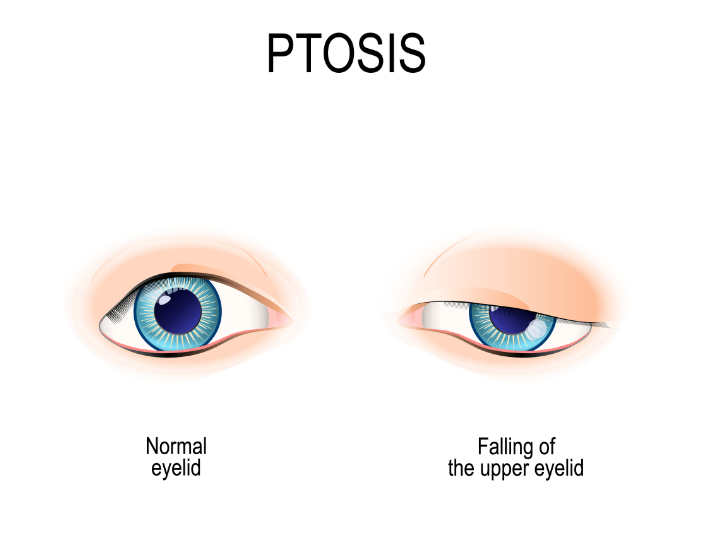Ptosis Causes
There are several causes of ptosis: congenital ptosis, weak muscles, and medical conditions. Congenital ptosis is drooping of the eyelids present from birth; however, it is sometimes diagnosed later in life. Congenital ptosis results from the levator muscle (the muscle responsible for elevating the upper eyelid) not functioning correctly. Another cause of ptosis might be weak eyelid muscles or the malfunctioning of nerves that control those eyelid muscles. In some cases, ptosis results from an injury or additional medical problems like a cyst or tumor. While the eyelid functions normally otherwise, a cyst, tumor, or swelling might increase the eyelid’s weight. If that occurs, the eyelid is likely to droop as a result of the eye muscles being too weak to account for the added weight.
Excess skin around the eyelids is another common cause of droopy eyelids. As you age, your eyelid muscles weaken and your skin stretches. The excess skin caused by aging might block your vision and require ptosis repair surgery.
What is Ptosis?
Ptosis is a painless eye condition where the upper eyelid droops. It’s commonly referred to as blepharoptosis. Patients with ptosis typically have “sleepy-looking” eyes or upper eyelids that slightly sag or cover the pupil. Ptosis can significantly affect your vision or have an undesired effect on your appearance.

Treatments
To combat the visual complications associated with droopy eyelids, ptosis repair surgery is an option. Even if your vision is not severely affected by ptosis, you might benefit from ptosis repair surgery for cosmetic reasons. To execute a treatment plan, an ophthalmologist must determine the cause of the ptosis. If the ptosis is not affecting the patient’s vision and they do not mind the appearance, then no treatment would be implemented. However, if the ptosis is affecting the patient’s visual field and/or their desired appearance, ptosis repair surgery or a blepharoplasty would be performed by an oculoplastic surgeon.
Ptosis surgery is an outpatient procedure that is performed under local anesthesia. Depending on the severity of the ptosis, there are two options for ptosis surgery:
- The oculoplastic surgeon will make a slight adjustment to the levator muscle in patients with less severe ptosis. No skin incision is required as the surgeon will perform the surgery from under the eyelid.
- In more severe cases, the surgeon will strengthen the levator muscle and reattach it to the eyelid. First, the surgeon will make an opening in the upper eyelid. After finding the levator muscle that raises the eyelid, they will place small stitches to tighten it. They will then raise the eyelid and close the incision of the eyelid with stitches.
Recovery happens in stages, and actual recovery time depends on the severity of the ptosis and the recommended treatment option.
If you or a loved one is experiencing any symptoms related to droopy eyelids or is unhappy with their eyelid appearance, schedule a consultation with one of our oculoplastic surgeons, Dr. Aliza Epstein or Dr. Gil Epstein. They are both members of the American Society of Ophthalmic Plastic and Reconstructive Surgery (ASOPRS) and have extensive experience performing ptosis repair surgery. Call today at 954-741-555.






